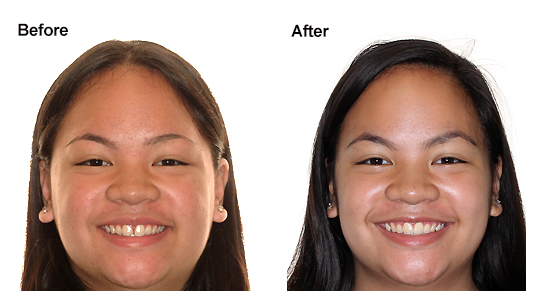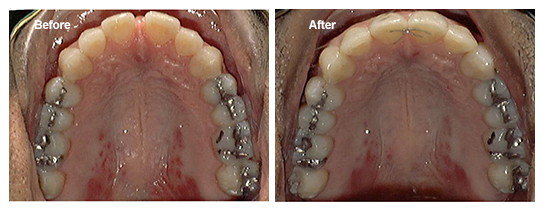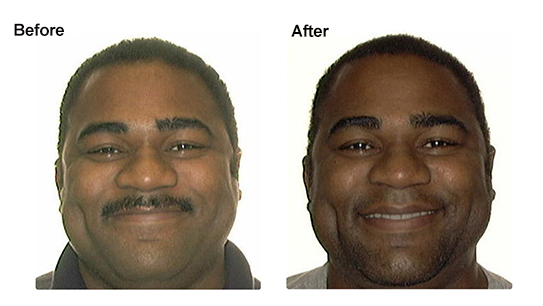November 15th, 2017

THE FRENUM, A THICK piece of tissue often found between the upper front teeth, may be responsible for your front tooth space. Your upper lip might even be attached with your thick frenum. This may be preventing you from smiling as big as you would like.

The Solution Is Simple
A thick frenum can be removed by laser or periodontal surgery. This procedure, called a frenectomy, is usually done by a periodontist (a gum and soft tissue dental specialist). Removal of your frenum is painless and relatively inexpensive. With a frenectomy and orthodontic treatment by braces or Invisalign, your orthodontic space can be held closed for a lifetime.

Keeping That Gap Closed
Following frenectomy, tooth space is held closed with either a removable or nonremovable retainer. With the aid of a bonded lingual retainer (inside tooth wire) your upper tooth space (diastema) may be gone forever.

Come visit us at Gorczyca Orthodontics in Antioch, California and let us help you be free of your frenum. Call us at 925-757-9000 for a free orthodontic exam. Visit us at www.clubbraces.com.
Be free of your frenum and enjoy the smile of your dreams!
Tags: orthodontist, orthodontics, braces, Invisalign, retainers, dental, lingual wire, fixed retainer, periodontist, retainer, diastema, frenectomy, frenum, dental specialist
Posted in Blog | No Comments
September 29th, 2016

A SPACE BETWEEN front teeth is very common. It called a diastema. Diastemas are often caused by thick tissue between the front teeth. This skin keeps your teeth apart and is called a maxillary frenum. Thick frenums are often hereditary and can be common in families.

How Do You Correct A Diastema?
A diastema is easy to close with orthodontic treatment. Short-term treatment may be braces, Invisalign, aligners, or removal appliances. Additional therapies may be required for ideal cosmetic results after closing a diastema. These may include veneers, lumineers, composites, or crowns. Periodontal therapy for removal of tissue, a frenectomy or gingivectomy, is often needed to help the space stay closed permanently after closing a diastema.

We Ensure The Gap Stays Closed
Your orthodontist may place a wire behind your front teeth to insure that your diastema stays closed. This bonded lingual wire is a permanent retainer. Care must be given not to bite hard foods with your permanent retainer to prevent it from breaking.

If you have questions about tooth gap closure call us at Gorczyca Orthodontics (925) 757-9000 for a complimentary consultation. Find us at www.clubbraces.com. To find an orthodontist in your area visit the American Associaton of Orthodontists at www.mylifemysmile.org.
Don't let a tooth gap keep you from smiling. Gap problem, no problem! Here's to your beautiful smile.
The content on this blog is not intended to be a substitute for professional medical advice, diagnosis, or treatment. Always seek the advice of qualified health providers with questions you may have regarding medical conditions.
Tags: Antioch, orthodontist, orthodontics, braces, Gorczyca Orthodontics, Invisalign, retainers, short term ortho, California, Aligners, permanent retainer, veneers, gingivectomy, retainer, crowns, cosmetic dentistry, Lumineers, diastema, frenectomy, orthodontic appliance, tooth gap, dental gap, removable appliance, appliance, dental appliance, bonded lingual, composites, adjunctive orthodontics
Posted in Blog | No Comments
July 20th, 2016

ANKYLOGLOSSIA, an excessive attachment of muscle or fascia to the undersurface and tip of the tongue can create speech problems in children as young and 1-2 years old. Later in life, it can also make eating an ice cream cone very difficult.
If you notice that your young child has a notch at the top of their tongue, or has difficulty sticking out their tongue or touching the tip of their tongue to their top lip, your child may have tongue-tie.
A Tongue-tie Can Be Easily Removed
A frenum or band of tissue causes tongue-tie. The tip of the tongue is held down to the floor of the mouth in tongue-tie and cannot protrude. This attachment can be easily removed by most pediatricians or a periodontist.
The earlier a pathologic frenum or tongue-tie can be treated, the less speech damage will be done or speech therapy will be required. It will also make eating easier, especially eating an ice cream cone.
The actual surgical procedure in frenectomy to cure tongue-tie is extremely simple. Often it is done with a laser with little pain and quick recovery. Tongue-tie is also rare and affects less than 1% of the population.
Let Us Know If You Have Any Questions!
If you have questions about tongue-tie, your orthodontist can help. In Antioch, California, contact orthodontist Dr. Ann Marie Gorczyca at www.clubbraces.com or call (925) 757-9000 for a tongue-tie evaluation if you have questions about tongue-tie.
Eating an ice cream cone should not be difficult. Be sure it is easy and remains one of the simple pleasures of life.
Tags: orthodontist, orthodontics, Gorczyca Orthodontics, Dr. Ann Marie Gorczyca, tongue, tongue-tie, ankyloglossia, speech, ice cream cone, frenectomy, frenum, laster
Posted in Blog | No Comments
















